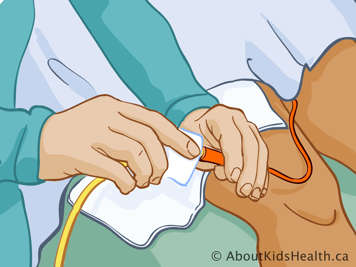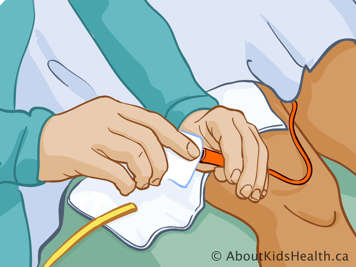Your child has come home from the hospital with a urinary catheter. A catheter is a thin tube. A urinary catheter drains urine (pee) from your child's bladder to the outside of the body.
There are some things you need to do to look after your child's catheter at home. Parents and older children can learn how to care for a catheter. Before your child goes home, a nurse will show you what to do. This page also explains what to do.
There are different types of urinary catheters:
- A Foley catheter enters your child's bladder through the tube that carries urine out of the body (the urethra).
- A suprapubic catheter enters your child's bladder through a cut in the belly.
You care for both these catheters the same way.
How to care for the catheter
- Try to get your child to drink at least six to eight glasses of liquid every day.
- Wash your hands with soap and water before and after you touch the catheter or urine.
- Check the catheter tubing every hour for leaks, loops or kinks.
- Keep your child's catheter taped firmly in place. Your child's nurse will show you how to do this before you leave the hospital.
- Never try to take the catheter out or put it back in by yourself.
- Always keep the catheter drainage bag lower than your child's bladder.
- Empty the catheter drainage bag at least two times each day.
- Clean your child's skin around the catheter every day. Use a clean tissue and povidone-iodine solution such as Betadine. If Betadine is not available, you can use soap and water. Let the Betadine dry for one minute. Then wipe it away with water.
- Give your child all medicine exactly as prescribed by your child's doctor.
- Irrigate your child's catheter as directed by your child's doctor.
Your child's catheter needs to be irrigated
From time to time, your child's catheter needs to be irrigated (rinsed). This helps the urine to drain freely.
Parents and older children can learn how to irrigate the catheter at home.
Your child's catheter may need to be irrigated for one or more of these reasons:
- if your child has bladder spasms
- if urine stops draining from the catheter
- if there is mucus in the urine
Some children need their catheter irrigated often and at set times. If this is true for your child, the doctor will give you a schedule to follow.
Use this space to write down when to irrigate your child's catheter:
A nurse will teach you how to irrigate your child's catheter
Before your child goes home from the hospital, the nurse will teach you how to irrigate the catheter.
You will need special supplies
You will need these supplies each time you irrigate your child's catheter:
- an alcohol swab
- a special salt water mixture called normal saline solution
- a 60 mL syringe with a tapered end
- a paper towel or other clean towel
Before your child goes home, the discharge planner will help you get these supplies.
To irrigate the catheter, follow these steps:
-

Wash your hands with soap and water. Gather the supplies you will need.
- Open a sterile syringe package and draw 30 mL of normal saline into it. Place the syringe back into the packaging to keep the tip sterile. Do not let the tip of the syringe touch anything else.
-

Put a clean towel under the catheter where it connects to the drainage tube. Use an alcohol swab to clean the connection site.
-

Pinch the catheter between your thumb and forefinger. Disconnect it from the drainage tubing. Put the end of the tubing on the clean towel.
-

Attach the sterile syringe to the end of the catheter. Gently push the plunger so all of the normal saline solution flows through the catheter. Once the normal saline is all in, gently pull back on the plunger to take it back out.
-

Clean the tip of the catheter with an alcohol swab. Clean the tip of the drainage tubing with an alcohol swab.
- Reconnect the catheter to the drainage tubing. Wash your hands again.
If it is hard to pull back on the plunger
Do not use force to pull back hard on the plunger. This could hurt your child's bladder. Instead, gently try to pull back again.
If it is still hard to pull back
Connect your child's catheter to the drainage tubing again. Watch for a good flow of urine.
- If urine flows well, irrigate again at the next scheduled time.
- If urine does not flow, bring your child to the hospital's emergency department right away. If your child's urologist has told you to do something else, do what the urologist told you.
Write down any special instructions from your child's urologist here:
Catheter problems that need a doctor or nurse
There are some catheter problems that you cannot take care of by yourself. These problems need a doctor or nurse:
- If the catheter comes out, do not try to put it back by yourself. Instead, go to the emergency department at the hospital right away.
- Normally, there should be a slow, steady flow of urine through the catheter. If there is much less urine than usual, call your child's surgeon or the urology resident on call in the hospital.
- If you notice a change in the colour of your child's urine, call your child's surgeon or the urology resident on call.
- If your child gets a fever or chills, call the urology resident on call.
Important phone numbers
Your child's surgeon:
Urology resident on call:
When to call the hospital
If the flow of urine slows down or stops; if you notice a change in the colour of your child's urine; or if your child has a fever or chills, you should see the doctor. You can also visit your local Emergency Room or the Hospital for Sick Children Emergency Department. If you have any questions, you may also contact your family physician or paediatrician.
At SickKids
Supporting your child
When preparing your child for an operation, the urology team recommends that whenever possible, your child and family members attend the Pre-Admission Program offered at SickKids. For more information call 416-813-6150 or visit the website at www.sickkids.ca.
A Child Life Specialist can also help to prepare and support your child if they are anxious about the operation.

